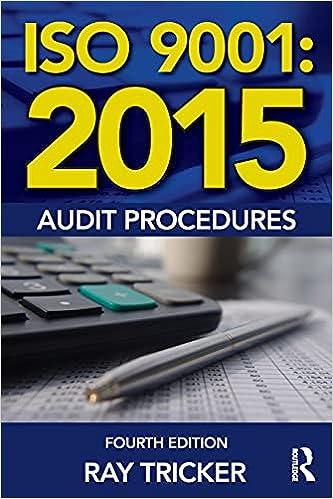Question
1.Allowance for Doubtful Accounts has a credit balance of $3,000 at the end of the year, before adjustments. Sales for the year amounted to $1,950,000,
1.Allowance for Doubtful Accounts has a credit balance of $3,000 at the end of the year, before adjustments. Sales for the year amounted to $1,950,000, and sales returns and allowances amounted to $50,000. If uncollectible accounts expense is estimated at 1% of net sales, the amount of the appropriate adjusting entry will be 2.If, instead of a percentage of net sales, the adjusting entry in Question 1 is based on an analysis of receivables that indicates doubtful accounts of $10,500, the amount of the adjustment will be 3.Allowance for Doubtful Accounts has a debit balance of $500 at the end of the year, before adjustment. If an analysis of receivables indicates doubtful accounts of $9,000, the amount of the appropriate adjusting entry will be 4.The maturity value of a $75,000, 180-day, 4% note receivable is 5.In writing off an uncollectible account by the direct write-off method, the account credited is 6.At the end of the fiscal year, after the accounts are closed, Accounts Receivable has a balance of $900,000, and Allowance for Doubtful Accounts has a balance of $75,000. What is the expected net realizable value of the receivables? 7.Where on the balance sheet would receivables that are expected to be realized in cash within one year be reported? 8.Allowance for Doubtful Accounts is listed on the appropriate financial statement in the subsection titled 9.Notes receivable expected to be collected in 1 years are listed on the financial statements in the subsection titled 10.If the receivable turnover is 10, how many days are the receivables outstanding, on the average? ACCOUNTS A.Accounts Payable E.Interest Expense I.Misc. Administrative Expense B.Accounts Receivable F.Interest Revenue J.Notes Payable C.Allowance for Doubtful Accounts G. Interest Payable K.Notes Receivable D.Cash H.Interest Receivable L.Bad Debt Expense 1-2.Recorded the adjusting entry for estimated uncollectible accounts at the end of the fiscal period, based upon the allowance method 3-4.Wrote off the account of the bankrupt debtor (included in Allowance for Doubtful Accounts provision had been made in Question 1-2) 5-8.Recovered the bad debt written off in Question 3-4 9-10.Replaced a customers account receivable with a note receivable Debit and credit for each...which account belongs in debit and credit for each...may be more than 1 choice.
Step by Step Solution
There are 3 Steps involved in it
Step: 1

Get Instant Access to Expert-Tailored Solutions
See step-by-step solutions with expert insights and AI powered tools for academic success
Step: 2

Step: 3

Ace Your Homework with AI
Get the answers you need in no time with our AI-driven, step-by-step assistance
Get Started


